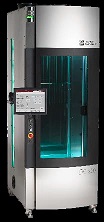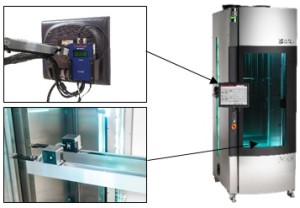Buying a UV Light Meter – Caveat Emptor – Buyer Beware
________________________________________
One major use for UV light began in the Semiconductor Industry decades ago. The use of UV light is a critical step in making integrated micro-devices better known today as “micro-chips or microprocessors.” Without UV measurement instruments, arguably, we would not have the far reaching electronics uses we have today. The process, using UV light and a photopolymer, transferred a 1 to 3 micron image (in 1975) from a glass “mask” to a silicon wafer. Because of these critical dimensions (geometries) any deviations emitted by the high pressure mercury arc UV light source created defects. Absolute accuracy and repeatable UV measurements were and still play a vital role in “micro-chip” manufacturing. Elements of UV light consisting of wavelength, intensity, and energy must be precisely measured and monitored otherwise thousands of dollars were lost and critical time wasted.
Basically, only two companies manufactured instruments to measure the UV light specifically necessary for that process. Optical Associates (OAI) founded by Jerry Bachur and George Richardson, founded in 1974, and located in Santa Clara, CA, on the West Coast and International Light, located on the East Coast. OAI, at that time, dominated the majority portion of this business. George Richardson, an engineer with an extensive background in UV light, designed OAI’s UV light meter and incorporated the NIST standards used in OAI’s calibration lab that became the “hallmark” for calibrating OAI’s UV Light Meters. The implementation of the NIST standard was absolutely essential for repeatable measurements since it eliminated many of the causes for costly defects in the semiconductor manufacturing process. Currently, Mr. Richardson is the owner of G&R Labs, founded in 1994, in Santa Clara, CA whose only business is manufacturing UV light meters and calibrating meters to this worldwide recognized NIST standard.
Since 1975, the uses for UV light applications has dramatically increased ranging from micro-chips manufacturing to medically uses and various disinfection applications. Along with this expansion, are the number of UV light meter manufacturers. This is where buyer beware comes in. Many of these UV meters, primarily, from the Far East, and some from Europe, have poorly designed electronics, sensor packages and provide a measurement number based upon “who knows what.” These meters are priced lower but without offering users accurate and repeatable UV measurements. As an example, just look on EBay. Because of this rapid expansion many of the new users for these applications have limited knowledge of UV light and are unaware of what goes into making a UV light meters. As a result, price becomes the driving point until problems arise. Viola, the reason for this article.
One key when purchasing a UV light meter is in the design. Calibration, calibration and calibration is  everything. Three essential factors are absolutely necessary to provide the user with an accurate, repeatable, and reliable UV light meter. First, one needs to calibrate the meter to a known and accepted worldwide standard. However, in order to achieve this kind of calibration, one must have the calibration lab resources to achieve the accuracy required, <0.5% to the NIST standard. Secondly, the design of the electronics must be linear, adjustable and stable, in order, for the UV meter to be calibrated and re-calibrated over time. Finally, the sensor package must be design using components that work together to insure the correct wavelength accurately measuring the light source being used and then not degrading overtime with usage.
everything. Three essential factors are absolutely necessary to provide the user with an accurate, repeatable, and reliable UV light meter. First, one needs to calibrate the meter to a known and accepted worldwide standard. However, in order to achieve this kind of calibration, one must have the calibration lab resources to achieve the accuracy required, <0.5% to the NIST standard. Secondly, the design of the electronics must be linear, adjustable and stable, in order, for the UV meter to be calibrated and re-calibrated over time. Finally, the sensor package must be design using components that work together to insure the correct wavelength accurately measuring the light source being used and then not degrading overtime with usage.
Another key consideration when purchasing a UV light meter deals with post purchase. There are several essential considerations to be addressed. First, if you have processing problems, the light source comes into question and is there someone you can speak with that understands UV light and your UV light meter? Mr. Richardson receives phone calls on a daily basis from users incurring problems across a wide variety of applications using UV light. Having an accessible contact is definitely a plus. The second post purchase consideration is calibration and repair. Sensor packages (probes) consisting of wires and glass stacks are attached to the electronics. People have a tendency to pull on the probe cable  not realizing that tiny wirers are used in the probe cabling. These wirers can break if not handled correctly. If they should break, where do you send the meter to be fixed? Which leads into the next consideration, calibration. If a wire should break, the meter must be re-calibrated. If the UV meter is a low end meter, is the business local or off shore that will repair it, if it can be repaired? Will the meter provide you with the same readout that you had prior to the repair? Whether the meter is sent in for repair or is needed to be periodically re-calibrated, as is suggested, the question of calibration standard is critical. The only worldwide accepted standard for measuring UV light is the National Bureau Institute of Technology (NIST). That is the gold standard. Any other standard, if used, will provide a relative measurement and probably unique to the manufacturer.
not realizing that tiny wirers are used in the probe cabling. These wirers can break if not handled correctly. If they should break, where do you send the meter to be fixed? Which leads into the next consideration, calibration. If a wire should break, the meter must be re-calibrated. If the UV meter is a low end meter, is the business local or off shore that will repair it, if it can be repaired? Will the meter provide you with the same readout that you had prior to the repair? Whether the meter is sent in for repair or is needed to be periodically re-calibrated, as is suggested, the question of calibration standard is critical. The only worldwide accepted standard for measuring UV light is the National Bureau Institute of Technology (NIST). That is the gold standard. Any other standard, if used, will provide a relative measurement and probably unique to the manufacturer.
Finally, another important consideration is the quality of the meter and the quality control implemented by the manufacturer producing the UV light meter. In the design, extreme care must be given in selecting all components whether they are in the electronics or in the sensor. Only through diligent quality control will these meters meet design specifications to insure an accurate, repeatable and reliable UV meter that can be calibrate to NIST standards. This is especially true with sensor component packages.
Key questions when considering purchasing a UV Light Meter:
• Is the meter initially calibrated to the NIST standard or an unknown number
• Where do I send the meter to be re-calibrated
• When re-calibrated is the same NIST standard used
• What is the turnaround time for calibration
• Is the meter’s electronics designed for re-calibration over the long term
• Will the sensors degrade over time leading to erroneous measurement errors
• Are different wavelength probes interchangeable with the electronic or do I have to purchase a another meter and probe
A word of caution. It is G&R Labs firm belief that all UV light meters should automatically include a NIST Calibration Certificate at no additional cost. Some UV meter manufacturers do not include this certificate and cannot provide one. Other manufacturers only include a certificate if purchase separately. Also, on the surface, it may appear a lower price is the way to go but only the long term will determine the real cost.
Photos supplied by: OakRiver Technology, a PaR Systems Company, a leader in the development and manufacture of high-end, automated equipment servicing the medical device and other high-tech industries with innovative technology platforms, http://www.par.com/life-science/
________________________________________
G&R Labs, 2395 De La Cruz Ave., Santa Clara, CA 95050 Tel: (408) 986-0377 website: grlabs.com